Experimental Evolution of Magnetite Nanoparticle Resistance in Escherichia coli
Abstract
1. Introduction
2. Materials and Methods
2.1. Bacterial Strains
2.2. Evolution Experiment
2.3. Determination of Minimal Inhibitory Concentration (MIC) of Magnetite NPs
2.4. Phenotypic Assays: 24-h Growth
2.5. Genomic Analysis
2.6. Preparation of Cells for Scanning Election Microscope
2.7. Inductively Coupled Plasma Optical Emission Spectrometry (ICP-OES) Analysis
2.8. Statistical Analysis
3. Results
3.1. Escherichia coli Can Rapidly Evolve Resistance to Stressful Levels of Magnetite NPs
3.2. Metal Resistance
3.3. Antibiotic Resistance
3.4. Cell Length and width Distribution
3.5. Whole Genome
4. Discussion
5. Conclusions
Author Contributions
Funding
Data Availability Statement
Acknowledgments
Conflicts of Interest
Appendix A
| (a) | |
|---|---|
| Digestion Parameters | Values |
| Power | 800 W |
| Temperature | 190 °C |
| Ramp Time | 25 min |
| Hold Time | 20 min |
| (b) | |
| ICP-OES Parameters | Values |
| RF Power | 1500 Watts |
| Nebulizer | GemCone Low Flow |
| Nebulizer Gas Flow rate | 0.80 L/min |
| Plasma Gas Flow rate- Argon | 10 L/min |
| Sample Flow rate | 1.50 mL/min |
| Iron (II) O-hour | Theoretical Concentration (mg/L) | Measured Concentration (mg/L) | Measured Concentration (mg/L) (24 h) |
|---|---|---|---|
| 0.00 | 0.00 | 0.00 | |
| 60 | 12.39 | 17.23 | |
| 120 | 33.14 | 35.83 | |
| 250 | 58.89 | 64.01 | |
| 500 | 91.88 | 124.62 | |
| 750 | 169.57 | 181.90 | |
| 1000 | 226.47 | 215.08 | |
| 1750 | 371.56 | 328.35 | |
| 2500 | 424.41 | 180.34 | |
| 5000 | 1039.31 | 1325.78 | |
| Iron (III) O-hour | |||
| 0 | 0 | 0.00 | |
| 60 | 13.10 | 10.70 | |
| 120 | 32.00 | 28.78 | |
| 250 | 71.12 | 58.34 | |
| 500 | 98.87 | 108.72 | |
| 750 | 208.18 | 167.00 | |
| 1000 | 232.15 | 215.97 | |
| 1750 | 406.15 | 354.42 | |
| 2500 | 502.55 | 506.06 | |
| 5000 | 1208.28 | 1897.90 | |
| Magnetite O-hour | |||
| 0 | 4.25 | 0.00 | |
| 60 | 35.87 | 34.73 | |
| 120 | 81.83 | 65.33 | |
| 250 | 114.47 | 142.27 | |
| 500 | 260.86 | 260.11 | |
| 750 | 495.13 | 254.63 | |
| 1000 | 577.89 | 384.57 | |
| 1750 | 883.52 | 308.12 | |
| 2500 | 1157.75 | 1199.82 | |
| 5000 | 2474.32 | 2421.73 |
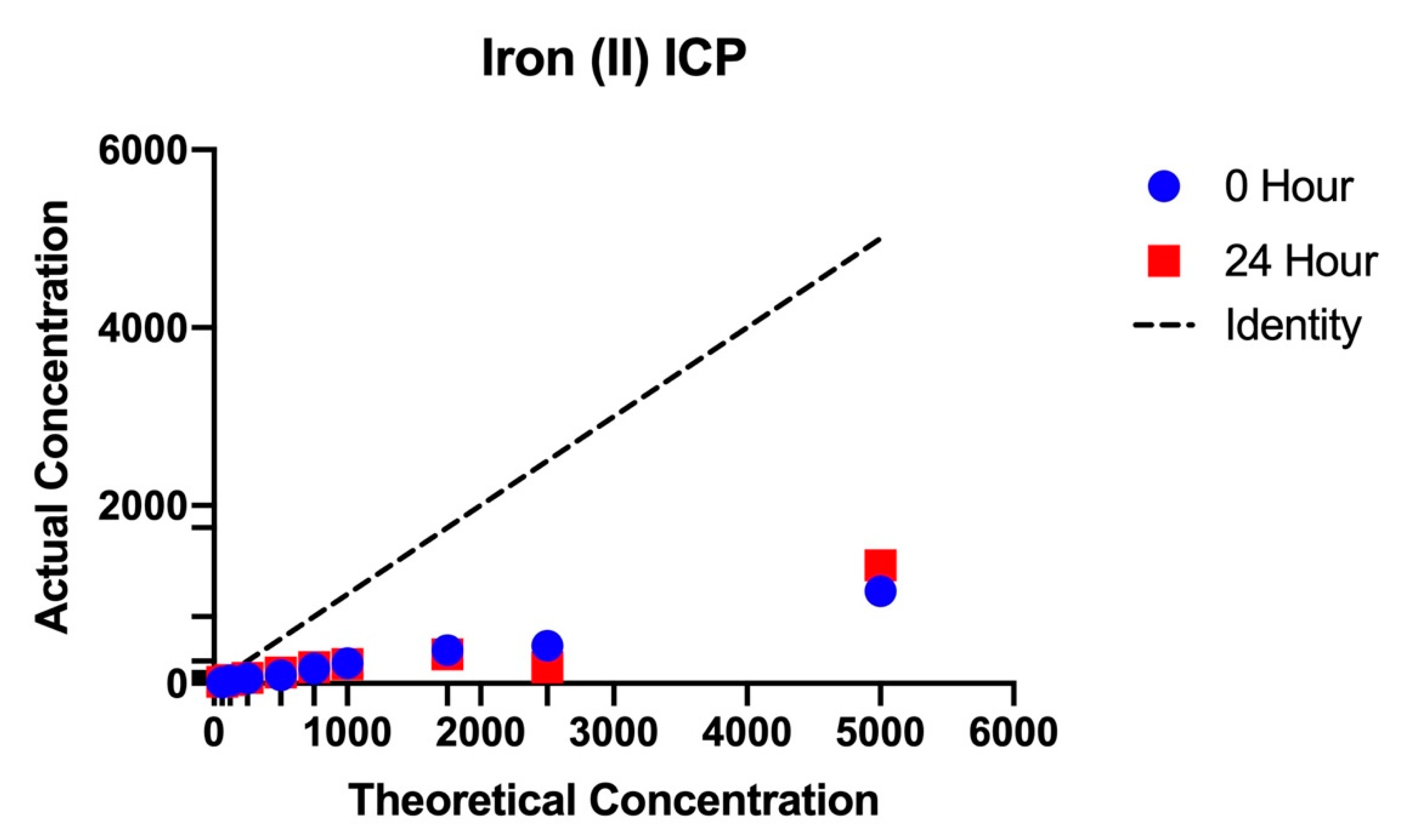
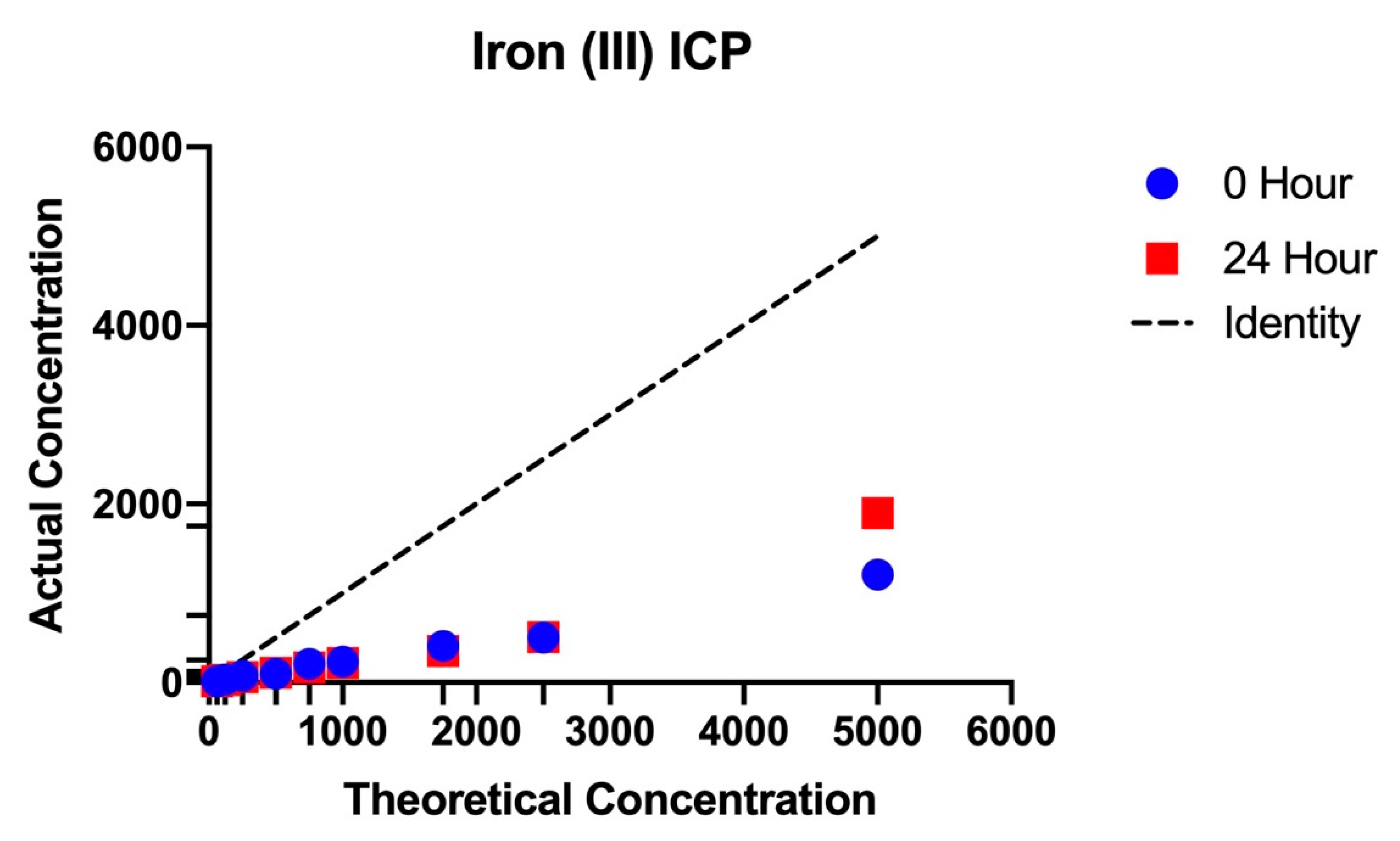
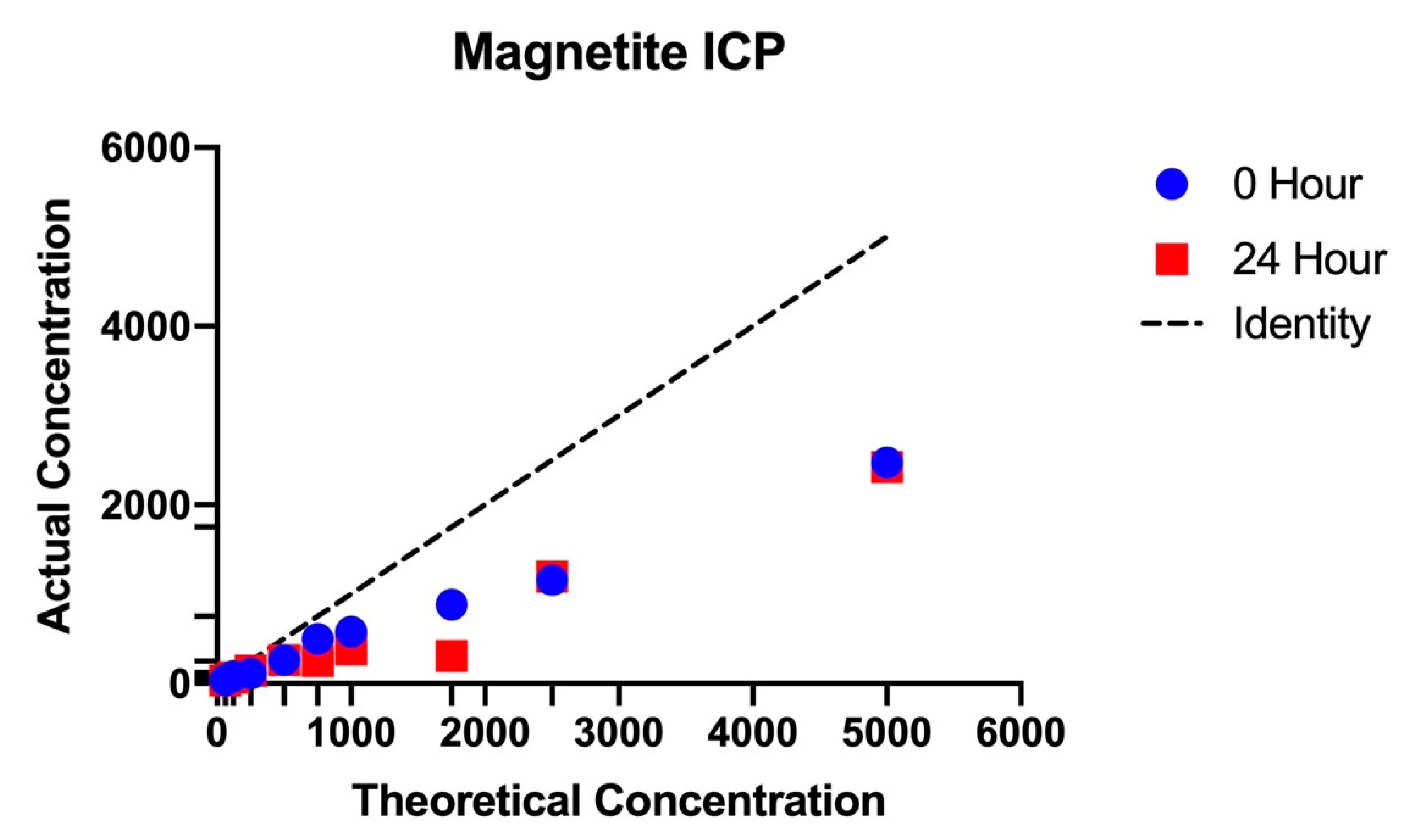
Appendix B
| Gene | Mutation | Annotation | C1 | C2 | C3 | C4 | C5 |
|---|---|---|---|---|---|---|---|
| ftsW→ | C→T | I377I (ATC→ATT) | 0.000 | 0.000 | 0.000 | 0.269 | 0.000 |
| mhpR← | G→A | R193C (CGC→TGC) | 0.000 | 0.295 | 0.000 | 0.000 | 0.000 |
| stfE← | C→G | pseudogene (1/501 nt) | 0.000 | 0.000 | 0.414 | 0.000 | 0.000 |
| yddH←/→nhoA | A→T | intergenic (−148/−25) | 0.000 | 0.000 | 0.366 | 0.000 | 0.000 |
| yejH→/→rplY | A→T | intergenic (+5/−120) | 0.000 | 0.441 | 0.000 | 0.000 | 0.000 |
| yejH→/→rplY | C→A | intergenic (+42/−83) | 0.000 | 0.443 | 0.000 | 0.000 | 0.000 |
| tktB→ | C→T | P369L (CCG→CTG) | 0.000 | 0.000 | 0.000 | 0.000 | 0.368 |
| ygeY→ | T→C | F233L (TTC→CTC) | 0.000 | 0.000 | 0.000 | 0.287 | 0.000 |
| xdhD→ | C→T | T878M (ACG→ATG) | 0.000 | 0.286 | 0.000 | 0.000 | 0.000 |
| treF→/←yhjB | A→G | intergenic (+14/+37) | 0.000 | 0.000 | 0.000 | 0.000 | 0.303 |
| pyrE←/←rph | Δ1 bp | intergenic (−41/+25) | 0.250 | 0.000 | 0.000 | 0.000 | 0.429 |
| rpoB→ | C→T | H526Y (CAC→TAC) | 0.000 | 0.000 | 0.000 | 0.540 | 0.000 |
| rpoB→ | C→T | S712F (TCC→TTC) | 0.000 | 0.000 | 0.000 | 0.000 | 0.259 |
| rpoB→ | G→A | E848K (GAA→AAA) | 0.000 | 0.000 | 0.000 | 0.359 | 0.000 |
| rpoB→ | G→T | Q1017H (CAG→CAT) | 0.000 | 0.328 | 0.000 | 0.000 | 0.000 |
| rpoC→ | +TCT | coding (2012/4224 nt) | 0.427 | 0.000 | 0.000 | 0.000 | 0.000 |
| Gene | Mutation | Annotation | C1 | C2 | C3 | C4 | C5 |
|---|---|---|---|---|---|---|---|
| caiT← | A→T | N41K (AAT→AAA) | 0.000 | 0.149 | 0.000 | 0.000 | 0.000 |
| yadL← | T→A | N179I (AAT→ATT) | 0.096 | 0.000 | 0.000 | 0.000 | 0.000 |
| afuC← | A→G | I315T (ATA→ACA) | 0.160 | 0.000 | 0.000 | 0.000 | 0.000 |
| yagG→ | G→A | S392N (AGC→AAC) | 0.000 | 0.168 | 0.000 | 0.000 | 0.000 |
| yahG→ | G→A | G212R (GGA→AGA) | 0.000 | 0.000 | 0.243 | 0.000 | 0.000 |
| prpD→ | G→C | T241T (ACG→ACC) | 0.000 | 0.000 | 0.000 | 0.000 | 0.169 |
| hyi→ | A→T | D198V (GAT→GTT) | 0.135 | 0.000 | 0.000 | 0.000 | 0.000 |
| sfmZ← | A→T | V50D (GTT→GAT) | 0.000 | 0.000 | 0.000 | 0.072 | 0.000 |
| nadA→ | A→G | A58A (GCA→GCG) | 0.000 | 0.236 | 0.000 | 0.000 | 0.000 |
| flgE→ | T→C | L325P (CTG→CCG) | 0.000 | 0.000 | 0.000 | 0.113 | 0.000 |
| nhaB← | A→T | V475E (GTG→GAG) | 0.000 | 0.000 | 0.000 | 0.242 | 0.000 |
| sapB← | A→G | F48S (TTT→TCT) | 0.123 | 0.000 | 0.000 | 0.000 | 0.000 |
| kilR← | G→A | A3V (GCA→GTA) | 0.000 | 0.000 | 0.000 | 0.000 | 0.179 |
| ldhA←/→ ydbH | A→T | intergenic (−200/−8) | 0.000 | 0.000 | 0.000 | 0.083 | 0.000 |
| hipB← | A→G | F4L (TTT→CTT) | 0.119 | 0.000 | 0.000 | 0.000 | 0.000 |
| ydfZ→ | A→T | T22S (ACC→TCC) | 0.000 | 0.000 | 0.000 | 0.160 | 0.000 |
| cheW←/←cheA | C→T | intergenic (−18/+3) | 0.000 | 0.000 | 0.000 | 0.000 | 0.236 |
| yedQ←/←yodC | A→T | intergenic (−105/+66) | 0.000 | 0.159 | 0.000 | 0.000 | 0.000 |
| metG→ | C→T | Q31 * (CAG→TAG) | 0.000 | 0.139 | 0.000 | 0.000 | 0.000 |
| fucP→ | G→A | A263A (GCG→GCA) | 0.110 | 0.000 | 0.000 | 0.000 | 0.000 |
| tcdA←/←mltA | T→A | intergenic (−118/+121) | 0.000 | 0.000 | 0.000 | 0.123 | 0.000 |
| ygeV←/→ ygeW | A→G | intergenic (−68/−408) | 0.000 | 0.000 | 0.000 | 0.000 | 0.197 |
| ygeV←/→ ygeW | G→A | intergenic (−344/−132) | 0.000 | 0.000 | 0.000 | 0.182 | 0.000 |
| serA← | C→T | D43N (GAT→AAT) | 0.000 | 0.160 | 0.000 | 0.000 | 0.000 |
| ygiD←/→ zupT | C→G | intergenic (−39/−104) | 0.000 | 0.000 | 0.000 | 0.000 | 0.098 |
| gltB→ | T→C | Y199Y (TAT→TAC) | 0.136 | 0.000 | 0.000 | 0.000 | 0.000 |
| crp→ | A→T | M60L (ATG→TTG) | 0.000 | 0.200 | 0.000 | 0.000 | 0.000 |
| bcsE→ | A→G | E243E (GAA→GAG) | 0.000 | 0.000 | 0.000 | 0.094 | 0.000 |
| yibG→ | G→A | E28K (GAA→AAA) | 0.084 | 0.000 | 0.000 | 0.000 | 0.000 |
| metL→ | C→T | A681V (GCG→GTG) | 0.000 | 0.000 | 0.226 | 0.000 | 0.000 |
| Gene | Position | Description |
|---|---|---|
| ftsW→ | 99,533 | lipid II flippase; integral membrane protein involved in stabilizing FstZ ring during cell division |
| mhpR← | 367,844 | mhp operon transcriptional activator |
| stfE← | 1,209,619 | pseudogene, e14 prophage; side tail fiber protein fragment family;Phage or Prophage Related |
| yddH←/→nhoA | 1,533,999 | flavin reductase like-protein/N-hydroxyarylamine O-acetyltransferase |
| yejH→/→rplY | 2,282,397 | putative ATP-dependent DNA or RNA helicase/50S ribosomal subunit protein L25 |
| yejH→/→rplY | 2,282,434 | putative ATP-dependent DNA or RNA helicase/50S ribosomal subunit protein L25 |
| tktB→ | 2,580,741 | transketolase 2, thiamine triphosphate-binding |
| ygeY→ | 3,009,460 | putative peptidase |
| xdhD→ | 3,023,948 | putative hypoxanthine oxidase, molybdopterin-binding/Fe-S binding |
| treF→/←yhjB | 3,671,255 | cytoplasmic trehalase/putative DNA-binding transcriptional response regulator |
| pyrE←/←rph | 3,815,809 | orotate phosphoribosyltransferase/ribonuclease PH (defective); enzyme; Degradation of RNA; RNase PH |
| rpoB→ | 4,182,820; 4,183,379; 4,183,786; 4,184, 295 | RNA polymerase, beta subunit |
| Gene | Position | Description |
|---|---|---|
| caiT← | 41,809 | putative transporter |
| yadL← | 151,696 | putative fimbrial-like adhesin protein |
| afuC← | 277,859 | CP4-6 prophage; putative ferric transporter subunit |
| yagG→ | 286,569 | CP4-6 prophage; putative sugar transporter |
| yahG→ | 338,958 | DUF1116 family protein |
| prpD→ | 351,937 | 2-methylcitrate dehydratase |
| hyi→ | 536,302 | hydroxypyruvate isomerase |
| sfmZ← | 564,332 | response regulator family protein |
| nadA→ | 782,258 | quinolinate synthase, subunit A |
| flgE→ | 1,133,547 | flagellar hook protein |
| nhaB← | 1,233,294 | sodium:proton antiporter |
| sapB← | 1,355,328 | antimicrobial peptide transport ABC transporter permease |
| kilR← | 1,418,222 | Rac prophage; inhibitor of ftsZ, killing protein |
| ldhA←/→ydbH | 1,443,043 | fermentative D-lactate dehydrogenase, NAD-dependent/putative membrane-anchored protein, function unknown |
| hipB← | 1,592,433 | antitoxin of HipAB toxin-antitoxin system |
| ydfZ→ | 1,629,278 | selenoprotein, function unknown |
| cheW←/←cheA | 1,973,357 | purine-binding chemotaxis protein/fused chemotactic sensory histidine kinase in two-component regulatory system with CheB and CheY: sensory histidine kinase/signal sensing protein |
| yedQ←/←yodC | 2,028,122 | putative membrane-anchored diguanylate cyclase/uncharacterized protein |
| metG→ | 2,194,390 | methionyl-tRNA synthetase |
| fucP→ | 2,935,023 | L-fucose transporter |
| tcdA←/←mltA | 2,945,960 | tRNA threonylcarbamoyladenosine dehydratase; sulfur acceptor for CsdA/membrane-bound lytic murein transglycosylase A |
| ygeV←/→ygeW | 3,005,854; 3,006,130 | putative sigma-54-interacting transcriptional activator/putative carbamoyltransferase |
| serA← | 3,058,284 | D-3-phosphoglycerate dehydrogenase |
| ygiD←/→zupT | 3,182,446 | 4,5-DOPA-extradiol-dioxygenase/zinc transporter |
| gltB→ | 3,355,321 | glutamate synthase, large subunit |
| crp→ | 3,486,297 | cAMP-activated global transcription factor, mediator of catabolite repression |
| bcsE→ | 3,697,186 | cellulose production protein |
| yibG→ | 3,768,258 | TPR-like repeat protein |
| metL→ | 4,131,876 | Bifunctional aspartokinase/homoserine dehydrogenase 2 |
References
- He, S.; Feng, Y.; Gu, N.; Zhang, Y.; Lin, X. The effect of γ-Fe2O3 nanoparticles on Escherichia coli genome. Environ. Pollut. 2011, 159, 3468–3473. [Google Scholar] [CrossRef]
- Hong, S.; Lu, X.; Gao, P. The exploration of the antibacterial mechanism of Fe3+ against bacteria. Braz. J. Microbiol. 2011, 42, 410–414. [Google Scholar]
- Guan, G.; Pinochet-Barros, A.; Gaballa, A.; Patel, S.J.; Argüello, J.M.; Helmann, J.D. PfeT, a P1B4 -type ATPase, effluxes ferrous iron and protects Bacillus subtilis against iron intoxication. Mol. Microbiol. 2015, 98, 787–803. [Google Scholar] [CrossRef]
- Fillat, M.F. The FUR (ferric uptake regulator) superfamily: Diversity and versatility of key transcriptional regulators. Arch. Biochem. Biophys. 2014, 546, 41–52. [Google Scholar] [CrossRef]
- Perez-Martin Escolar, L.; Perez-Martin, J.; Lorenzo, V. Opening the Iron Box: Transcriptional Metalloregulation by the Fur Protein. J. Bacteriol. 1999, 181, 6223–6229. [Google Scholar] [CrossRef] [PubMed]
- Lill, R. Function and biogenesis of iron-sulphur proteins. Nature 2009, 460, 831–838. [Google Scholar] [CrossRef] [PubMed]
- Grass, G. Iron transport in Escherichia coli: All has not been said and done. BioMetals 2005, 19, 159–172. [Google Scholar] [CrossRef] [PubMed]
- Coale, K.H.; Johnson, K.S.; Fitzwater, S.E.; Gordon, R.M.; Tanner, S.; Chavez, F.P.; Ferioli, L.; Sakamoto, C.; Rogers, P.; Millero, F.; et al. A massive phytoplankton bloom induced by an ecosystem-scale iron fertilization experiment in the equatorial Pacific Ocean. Nature 1996, 383, 495–501. [Google Scholar] [CrossRef]
- Konopka, K.; Neilands, J.B. Effect of serum albumin on siderophore-mediated utilization of transferrin iron. Biochemistry 1984, 23, 2122–2127. [Google Scholar] [CrossRef] [PubMed]
- Nakashige, T.G.; Zhang, B.; Krebs, C.; Nolan, E.M. Human calprotectin is an iron-sequestering host-defense protein. Nat. Chem. Biol. 2015, 11, 765–771. [Google Scholar] [CrossRef]
- Seo, S.W.; Kim, D.; Latif, H.; O’Brien, E.J.; Szubin, R.; Palsson, B.O. Deciphering Fur transcriptional regulatory network highlights its complex role beyond iron metabolism in Escherichia Coli. Nat. Commun. 2014, 5, 4910. [Google Scholar] [CrossRef]
- Hale, R.; Morrongiello, J.R.; Swearer, S.E. Evolutionary traps and range shifts in a rapidly changing world. Biol. Lett. 2016, 12, 20160003. [Google Scholar] [CrossRef]
- Thomas, M.D.; Ewunkem, A.J.; Williams, D.K.; Moore, A.; Rhinehardt, K.; Van Beveren, E.; Yang, B.; Boyd, B.; Tapia, A.; Han, J.; et al. Too much of a good thing: Adaptation to iron (II) in Escherichia coli. Evol. Med. Public Health 2021, 9, 53–67. [Google Scholar] [CrossRef] [PubMed]
- Graves, J.L.; Ewunkem, A.J.; Thomas, M.D.; Han, J.; Rhinehardt, K.L.; Boyd, S.; Edmondson, R.; Jeffers-Francis, L.; Harrison, S.H. Experimental Evolution of Metal Resistance in Bacteria. In Evolution in Action—Past, Present, and Future; Springer International Publishing, AG: Cham, Switzerland, 2020; pp. 91–106. [Google Scholar]
- Graves, J.L.; Ewunkem, J.; Ward, J.; Staley, C.; Thomas, M.D.; Rhinehardt, K.L.; Han, J.; Harrison, S.H. Experimental evolution of gallium resistance in Escherichia coli. Evol. Med. Public Health 2019, 2019, 169–180. [Google Scholar] [CrossRef]
- Laurent, S.; Forge, D.; Port, M.; Roch, A.; Robic, C.; Vander Elst, L.; Muller, R.N. Magnetic iron oxide nanoparticles: Synthesis, stabilization, vectorization, physicochemical characterizations, and biological applications. Chem. Rev. 2008, 108, 2064–2110. [Google Scholar] [CrossRef]
- Hett, A. Nanotechnology: Small Matter, Many Unknowns; Swiss Reinsurance Company: Zürich, Switzerland, 2004. [Google Scholar]
- Khan, I.; Saeed, K.; Khan, I. Nanoparticles: Properties, applications and toxicities. Arab. J. Chem. 2019, 12, 908–931. [Google Scholar] [CrossRef]
- Niño-Martínez, N.; Salas Orozco, M.F.; Martínez-Castañón, G.A.; Torres Méndez, F.; Ruiz, F. Molecular mechanisms of bacterial resistance to metal and metal oxide nanoparticles. Int. J. Mol. Sci. 2019, 20, 2808. [Google Scholar] [CrossRef] [PubMed]
- Chamchoy, K.; Inprasit, T.; Vanichvattanadecha, C.; Thiangtrong, A.; Anukunwithaya, P.; Pisitsak, P. The Magnetic Properties and Dye Adsorption of Sericin-modified Magnetite Nanoparticles. J. Polym. Environ. 2021, 29, 484–491. [Google Scholar] [CrossRef]
- Siponen, M.I.; Legrand, P.; Widdrat, M.; Jones, S.R.; Zhang, W.J.; Chang, M.C.; Faivre, D.; Arnoux, P.; Pignol, D. Structural insight into magnetochrome-mediated magnetite biomineralization. Nature 2013, 502, 681–684. [Google Scholar] [CrossRef] [PubMed]
- Gieré, R. Magnetite in the human body: Biogenic vs. anthropogenic. Proc. Natl. Acad. Sci. USA 2016, 113, 11986–11987. [Google Scholar] [CrossRef] [PubMed]
- Peters, S.T.; Alibabaie, N.; Pack, A.; McKibbin, S.J.; Raeisi, D.; Nayebi, N.; Torab, F.; Ireland, T.; Lehmann, B. Triple oxygen isotope variations in magnetite from iron-oxide deposits, central Iran, record magmatic fluid interaction with evaporite and carbonate host rocks. Geology 2019, 48, 211–215. [Google Scholar] [CrossRef]
- Ayupova, N.R.; Novoselov, K.A.; Maslennikov, V.V.; Melekestseva, I.Y.; Hollis, S.P.; Artemyev, D.A.; Tessalina, S.G. The formation of magnetite ores of the Glubochenskoe deposit, Turgai iron belt, Russia: New structural, mineralogical, geochemical, and isotopic constraints. Miner. Depos. 2021, 56, 103–123. [Google Scholar] [CrossRef]
- Kirschvink, J.L.; Kobayashi-Kirschvink, A.; Woodford, B.J. Magnetite biomineralization in the human brain. Proc. Natl. Acad. Sci. USA 1992, 89, 7683–7687. [Google Scholar] [CrossRef]
- Kim, D.H.; Nikles, D.E.; Brazel, C.S. Synthesis and characterization of multifunctional chitosan-MnFe2O4 nanoparticles for magnetic hyperthermia and drug delivery. Materials 2010, 3, 4051–4065. [Google Scholar] [CrossRef] [PubMed]
- Alvarez-Berríos, M.P.; Castillo, A.; Rinaldi, C.; Torres-Lugo, M. Magnetic fluid hyperthermia enhances cytotoxicity of bortezomib in sensitive and resistant cancer cell lines. Int. J. Nanomed. 2014, 9, 145. [Google Scholar]
- Tokajuk, G.; Niemirowicz, K.; Deptuła, P.; Piktel, E.; Cieśluk, M.; Wilczewska, A.Z.; Dąbrowski, J.R.; Bucki, R. Use of magnetic nanoparticles as a drug delivery system to improve chlorhexidine antimicrobial activity. Int. J. Nanomed. 2017, 12, 7833. [Google Scholar] [CrossRef]
- de Toledo, L.D.A.S.; Rosseto, H.C.; Bruschi, M.L. Iron oxide magnetic nanoparticles as antimicrobials for therapeutics. Pharm. Dev. Technol. 2018, 23, 316–323. [Google Scholar] [CrossRef] [PubMed]
- Wang, J.; Wu, H.; Yang, Y.; Yan, R.; Zhao, Y.; Wang, Y.; Chen, A.; Shao, S.; Jiang, P.; Li, Y. Bacterial species-identifiable magnetic nanosystems for early sepsis diagnosis and extracorporeal photodynamic blood disinfection. Nanoscale 2018, 10, 132–141. [Google Scholar] [CrossRef] [PubMed]
- Iqbal, J.; Abbasi, B.A.; Ahmad, R.; Shahbaz, A.; Zahra, S.A.; Kanwal, S.; Kanwal, S.; Munir, A.; Rabbani, A.; Mahmood, T. Biogenic synthesis of green and cost-effective iron nanoparticles and evaluation of their potential biomedical properties. J. Mol. Struct. 2020, 1199, 126979. [Google Scholar] [CrossRef]
- Taimoory, S.M.; Rahdar, A.; Aliahmad, M.; Sadeghfar, F.; Hajinezhad, M.R.; Jahantigh, M.; Shahbazi, P.; Trant, J.F. The synthesis and characterization of a magnetite nanoparticle with potent antibacterial activity and low mammalian toxicity. J. Mol. Liq. 2018, 265, 96–104. [Google Scholar] [CrossRef]
- Oliveira, A.M.D.; Mateus, G.A.P.; Santos, T.R.T.D.; Filho, B.A.D.A.; Gomes, R.G.; Bergamasco, R. Functionalized magnetite nanoparticles with Moringa oleifera with potent antibacterial action in wastewater. Environ. Technol. 2020, 1–10. [Google Scholar] [CrossRef]
- Ismail, R.A.; Sulaiman, G.M.; Abdulrahman, S.A.; Marzoog, T.R. Antibacterial activity of magnetic iron oxide nanoparticles synthesized by laser ablation in liquid. Mater. Sci. Eng. C 2015, 53, 286–297. [Google Scholar] [CrossRef]
- Wilczewska, A.Z.; Niemirowicz, K.; Markiewicz, K.H.; Car, H. Nanoparticles as drug delivery systems. Pharma. Rep. 2012, 64, 1020–1037. [Google Scholar] [CrossRef]
- Gabrielyan, L.; Hakobyan, L.; Hovhannisyan, A.; Trchounian, A. Effects of iron oxide (Fe3O4) nanoparticles on Escherichia coli antibiotic-resistant strains. J. Appl. Microbiol. 2019, 126, 1108–1116. [Google Scholar] [CrossRef] [PubMed]
- International Organization for Standardization. Clinical Laboratory Testing and in Vitro Diagnostic Test Systems-Susceptibility Testing of Infectious Agents and Evaluation of Performance of Antimicrobial Susceptibility Test Devices: Reference Method for Testing the in Vitro Activity of Antimicrobial Agents Against Rapidly Growing Aerobic Bacteria Involved in Infectious Diseases; ISO: Geneva, Switzerland, 2006. [Google Scholar]
- Mabrouk, M.; Abd El-Wahab, R.M.; Beherei, H.H.; Selim, M.M.; Das, D.B. Multifunctional magnetite nanoparticles for drug delivery: Preparation, characterization, antibacterial properties and drug release kinetics. Int. J. Pharm. 2020, 587, 119658. [Google Scholar] [CrossRef]
- Deatherage, D.E.; Barrick, J.E. Identification of mutations in laboratory-evolved microbes from next-generation sequencing data using breseq. Methods Mol. Biol. 2014, 1151, 165–188. [Google Scholar] [CrossRef] [PubMed]
- Cao, J.; Woodhall, M.R.; Alvarez, J.; Cartron, M.L.; Andrews, S.C. EfeUOB (YcdNOB) is a tripartite, acid-induced and CpxAR-regulated, low-pH Fe2+ transporter that is cryptic in Escherichia coli K-12 but functional in E. coli O157:H7. Mol. Microbiol. 2007, 65, 857–875. [Google Scholar] [CrossRef]
- Graves, J.L., Jr.; Tajkarimi, M.; Cunningham, Q.; Campbell, A.; Nonga, H.; Harrison, S.H.; Barrick, J.E. Rapid evolution of silver nanoparticle resistance in Escherichia Coli. Front. Genet. 2015, 6, 42. [Google Scholar] [CrossRef]
- Tajkarimi, M.; Rhinehardt, K.; Thomas, M.; Ewunkem, J.A.; Campbell, A.; Boyd, S.; Turner, D.; Harrison, S.H.; Graves, J.L. Selection for ionic- confers silver nanoparticle resistance in Escherichia coli. JSM Nanotechnol. Nanomed. 2017, 5, 1047. [Google Scholar]
- Kenzaka, T.; Tani, K. Scanning electron microscopy imaging of bacteria based on nucleic acid sequences. In Scanning Electron Microscopy; Intech Open: London, UK, 2012. [Google Scholar]
- Barber, D.S.; Denslow, N.D.; Griffitt, R.J.; Martyniuk, C.J. Sources, fate, and effects of engineered nanomaterials in the aquatic environment. In Nanotoxicity: From In Vivo and In Vitro Models to Health Risks; Sahu, S.C., Casciano, D.A., Eds.; Wiley: West Sussex, UK, 2009. [Google Scholar]
- Wu, H.; Yin, J.J.; Wamer, W.G.; Zeng, M.; Lo, Y.M. Reactive oxygen species-related activities of nano-iron metal and nano-iron oxides. J. Food Drug Anal. 2014, 22, 86–94. [Google Scholar] [CrossRef] [PubMed]
- Rajab, S.; Tabandeh, F.; Shahraky, M.K.; Alahyaribeik, S. The effect of lactobacillus cell size on its probiotic characteristics. Anaerobe 2020, 62, 102103. [Google Scholar] [CrossRef]
- Vijay, S.; Vinh, D.N.; Hai, H.T.; Ha, V.T.N.; Dung, V.T.M.; Dinh, T.D.; Nhung, H.N.; Tram, T.T.B.; Aldridge, B.B.; Hanh, N.T.; et al. Influence of stress and antibiotic resistance on cell-length distribution in Mycobacterium tuberculosis clinical isolates. Front. Microbiol. 2017, 8, 2296. [Google Scholar] [CrossRef] [PubMed]
- Manina, G.; Dhar, N.; McKinney, J.D. Stress and host immunity amplify Mycobacterium tuberculosis phenotypic heterogeneity and induce nongrowing metabolically active forms. Cell Host Microbe 2015, 17, 32–46. [Google Scholar] [CrossRef] [PubMed]
- Priestman, M.; Thomas, P.; Robertson, B.D.; Shahrezaei, V. Mycobacteria modify their cell size control under sub-optimal carbon sources. Front. Cell Dev. Biol. 2017, 5, 64. [Google Scholar] [CrossRef] [PubMed]
- Justice, S.S.; Hunstad, D.A.; Cegelski, L.; Hultgren, S.J. Morphological plasticity as a bacterial survival strategy. Nat. Rev. Microbiol. 2008, 6, 162–168. [Google Scholar] [CrossRef] [PubMed]
- Koch, A.; Mizrahi, V.; Warner, D.F. The impact of drug resistance on Mycobacterium tuberculosis physiology: What can we learn from rifampicin? Emerg. Microbes Infect. 2014, 3, 1–11. [Google Scholar] [CrossRef] [PubMed]
- Monds, R.D.; Lee, T.K.; Colavin, A.; Ursell, T.; Quan, S.; Cooper, T.F.; Huang, K.C. Systematic perturbation of cytoskeletal function reveals a linear scaling relationship between cell geometry and fitness. Cell Rep. 2014, 9, 1528–1537. [Google Scholar] [CrossRef] [PubMed]
- Bos, J.; Zhang, Q.; Vyawahare, S.; Rogers, E.; Rosenberg, S.M.; Austin, R.H. Emergence of antibiotic resistance from multinucleated bacterial filaments. Proc. Natl. Acad. Sci. USA 2015, 112, 178–183. [Google Scholar] [CrossRef]
- Rodríguez-Verdugo, A.; Carrillo-Cisneros, D.; González-González, A.; Gaut, B.S.; Bennett, A.F. Different tradeoffs result from alternate genetic adaptations to a common environment. Proc. Natl. Acad. Sci. USA 2014, 111, 12121–12126. [Google Scholar] [CrossRef]
- Cheng, K.K.; Lee, B.S.; Masuda, T.; Ito, T.; Ikeda, K.; Hirayama, A.; Deng, L.; Dong, J.; Shimizu, K.; Soga, T.; et al. Global metabolic network reorganization by adaptive mutations allows fast growth of Escherichia coli on glycerol. Nat. Commun. 2014, 5, 1–9. [Google Scholar] [CrossRef]
- Petcharoen, K.; Sirivat, A. Synthesis and characterization of magnetite nanoparticles via the chemical co-precipitation method. Mater. Sci. Eng. B 2012, 177, 421–427. [Google Scholar] [CrossRef]
- Wei, L.; Lu, J.; Xu, H.; Patel, A.; Chen, Z.S.; Chen, G. Silver nanoparticles: Synthesis, properties, and therapeutic applications. Drug Discov. Today 2015, 20, 595–601. [Google Scholar] [CrossRef] [PubMed]
- Kaushik, D.; Mohan, M.; Bora De, D.M.; Swami, O.C. Ampicillin: Rise fall and resurgence. JCDR 2014, 8, ME01. [Google Scholar] [PubMed]
- Grossman, T.H. Tetracycline antibiotics and resistance. Cold Spring Harb. Perspect. Med. 2016, 6, a025387. [Google Scholar] [CrossRef]
- Samigulina, G.A.; Samigulina, Z.I. Drag design of sulfanilamide based on the technology of immune network modeling and ontological approach. In Proceedings of the 2016 IEEE 10th International Conference on Application of Information and Communication Technologies 2016, (AICT), Azerbaijan, Baku, 12–14 October 2016; pp. 1–5. [Google Scholar]
- Chandrasekaran, K.; Varaprasad, K.; Venugopal, S.K.; Arun, L.; Hameed, A.S.H. Synergistic antibacterial effect of the magnesium-doped ZnO nanoparticles with chloramphenicol. BioNanoScience 2020, 10, 106–111. [Google Scholar] [CrossRef]
- Somoskovi, A.; Parsons, L.M.; Salfinger, M. The molecular basis of resistance to isoniazid, rifampin, and pyrazinamide in Mycobacterium tuberculosis. Respir. Res. 2001, 2, 164. [Google Scholar] [CrossRef]
- White-Ziegler, C.A.; Um, S.; Perez, N.M.; Berns, A.L.; Malhowski, A.J.; Young, S. Low temperature (23 C) increases expression of biofilm-, cold-shock-and RpoS-dependent genes in Escherichia coli K-12. Microbiology 2008, 154, 148–166. [Google Scholar] [CrossRef] [PubMed]
- Zaw, M.T.; Emran, N.A.; Lin, Z. Mutations inside rifampicin-resistance determining region of rpoB gene associated with rifampicin-resistance in Mycobacterium tuberculosis. J. Infect. Public Health 2018, 11, 605–610. [Google Scholar] [CrossRef]
- Knöppel, A.; Näsvall, J.; Andersson, D.I. Evolution of antibiotic resistance without antibiotic exposure. Antimicrob. Agents Chemother. 2017, 61. [Google Scholar] [CrossRef]
- Graves, J.L.; Thomas, M.; Ewunkem, J.A. Antimicrobial Nanomaterials: Why Evolution Matters. Nanomaterials 2017, 7, 283. [Google Scholar] [CrossRef]
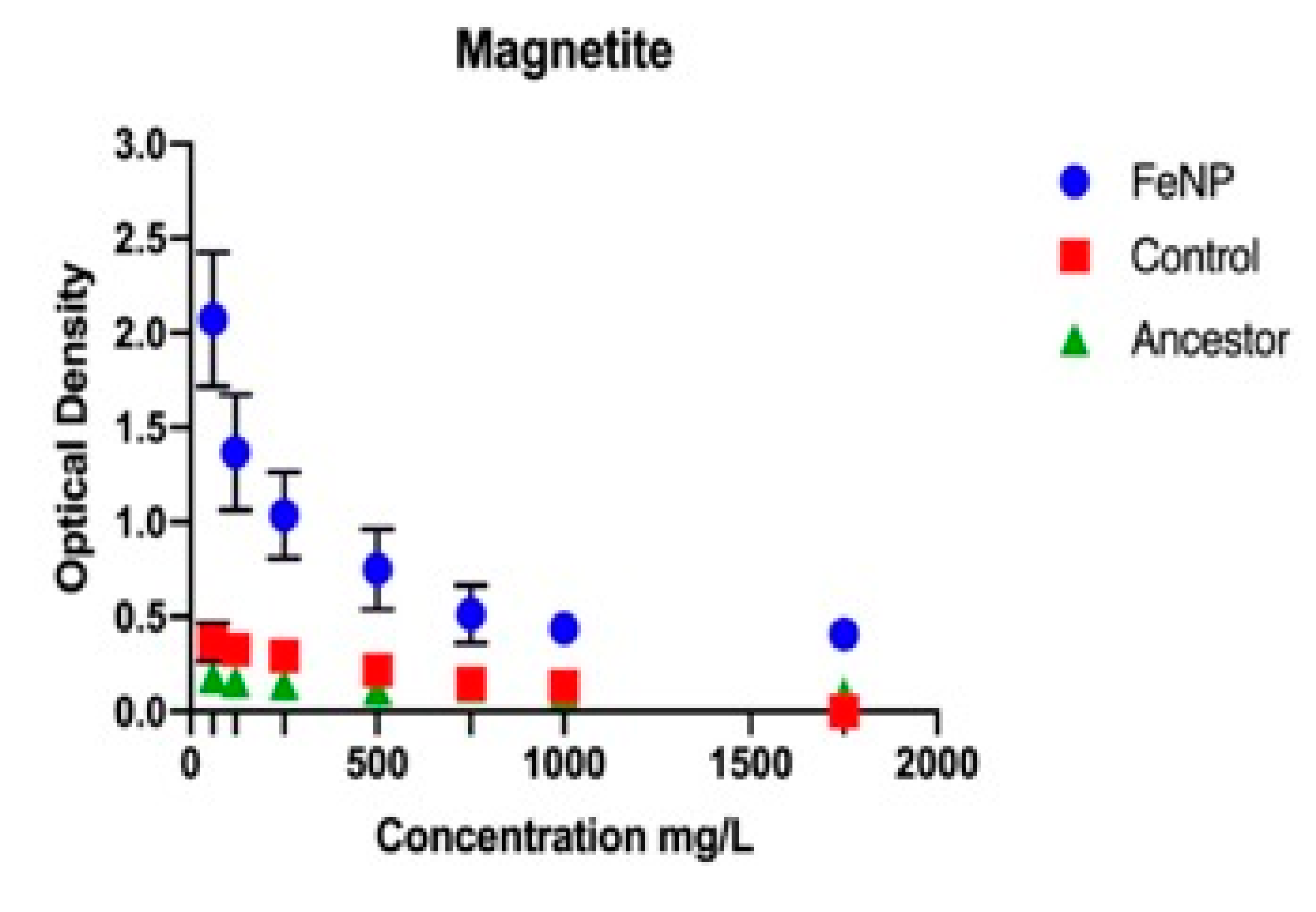
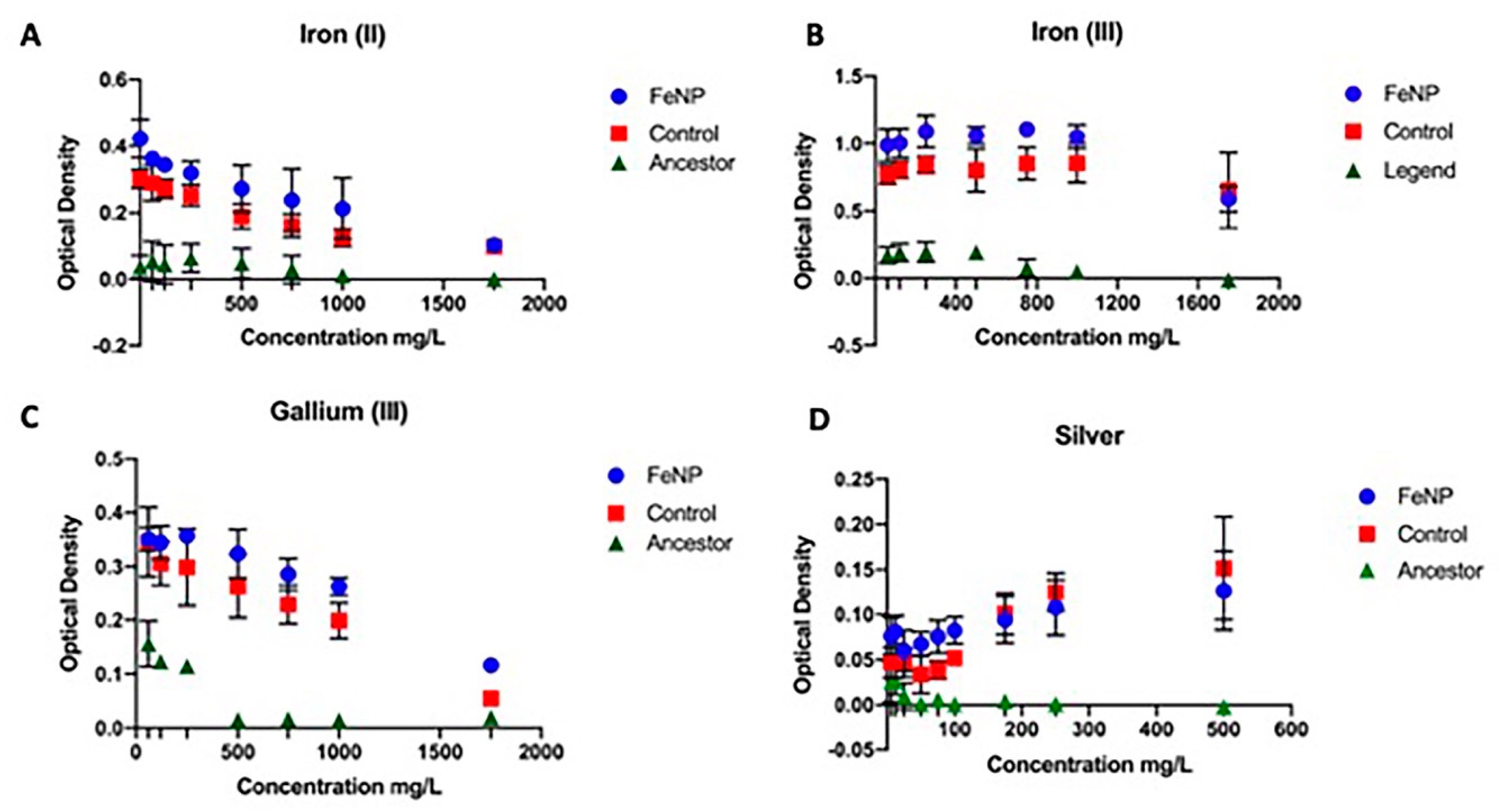
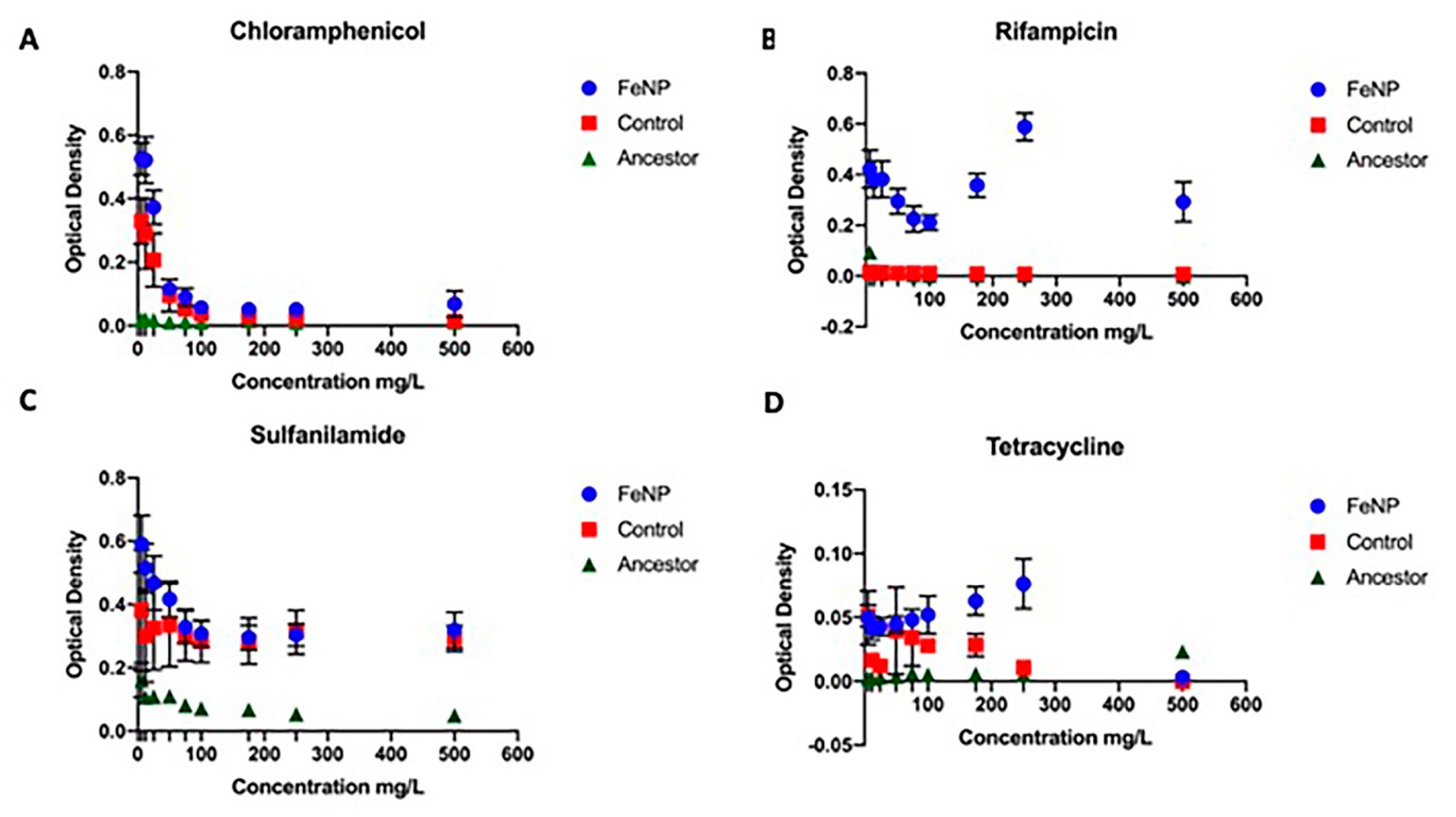
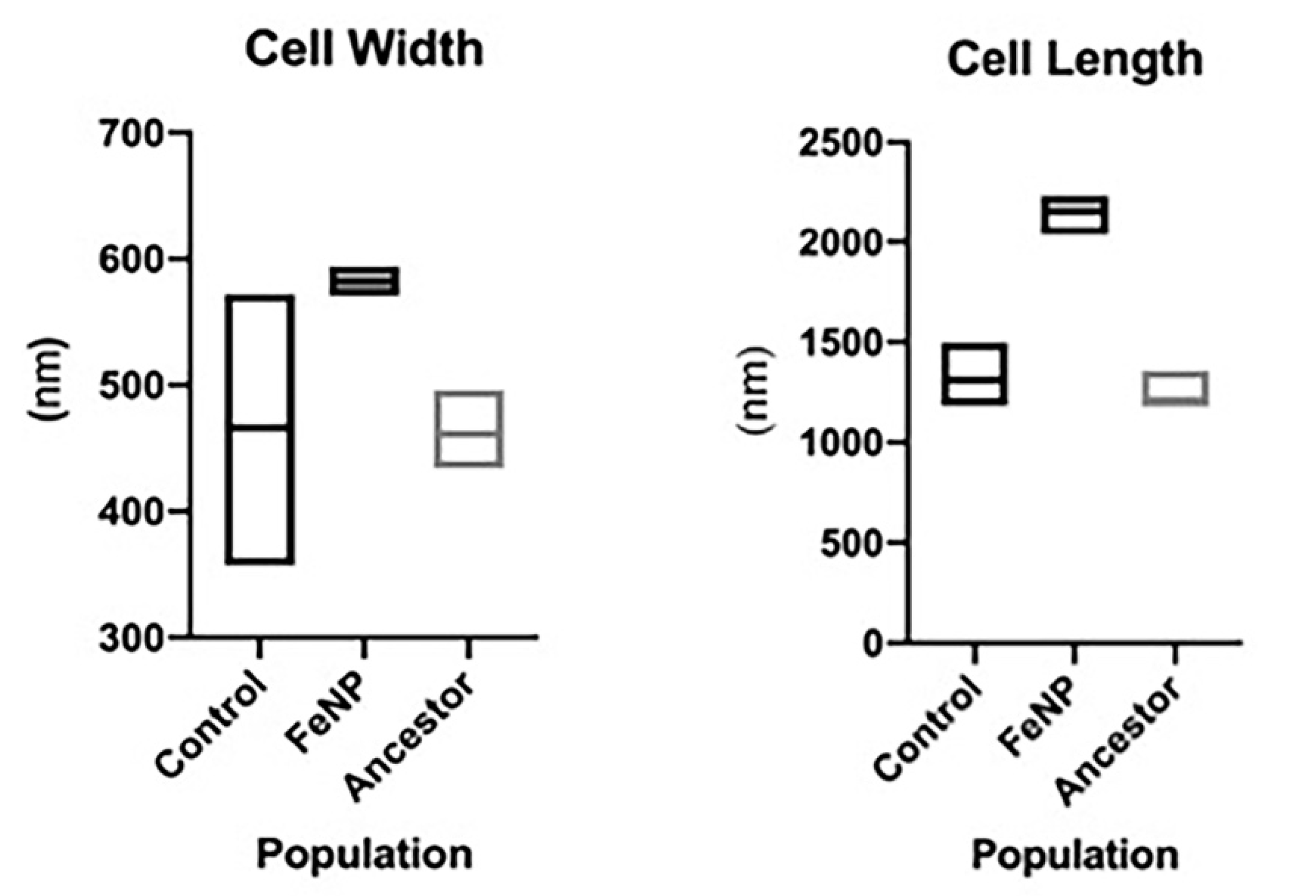
| Mechanism | Fe |
|---|---|
| Reactive oxygen species | + |
| Disruption of transcription/translation | + |
| Damage to cell wall/membrane | + |
| Interfering with respiration | + |
| Release of cellular components | + |
| Binding to thiol groups | + |
| (a) | |||
|---|---|---|---|
| Substance | Pop. Effect (F, p) | Conc. Effect (F, p) | Interaction (F, p) |
| magnetite | 383.9, 0.001 | 42.5, 0.001 | 25.9, 0.001 |
| ampicillin | 283.1, 0.001 | 17.1, 0.001 | 16.7, 0.001 |
| chloramphenicol | 71.1, 0.001 | 114.6, 0.001 | 7.9, 0.001 |
| rifampicin | 1285.1, 0.001 | 16.3, 0.001 | 16.5, 0.001 |
| tetracycline | 62.9, 0.001 | 12.6, 0.001 | 5.7, 0.001 |
| iron (II) | 18.6, 0.001 | 88.0, 0.001 | 1.7, 0.116 |
| iron (III) | 42.9, 0.001 | 77.4, 0.001 | 2.7, 0.011 |
| gallium (III) | 29.8, 0.001 | 111.8, 0.001 | 1.2, 0.278 |
| silver (I) | 7.1, 0.009 | 15.8, 0.001 | 2.3, 0.029 |
| (b) | |||
| Substance | Pop. Effect (F, p) | Conc. Effect (F, p) | Interaction (F, p) |
| magnetite | 9.5, 0.003 | 22.7, 0.001 | 12.8, 0.001 |
| chloramphenicol | 159.1, 0.001 | 25.7, 0.001 | 22.6, 0.001 |
| silver (I) | 243.1, 0.001 | 10.4, 0.001 | 15.6, 0.001 |
| (a) | |||||||
|---|---|---|---|---|---|---|---|
| Gene | Mutation | Annotation | FeNp1 | FeNp2 | FeNp3 | FeNp4 | FeNp5 |
| rpoC→ | A→T | D410V (GAT→GTT) | 0.000 | 0.000 | 0.000 | 0.000 | 1.000 |
| rpoC→ | A→G | D622G (GAC→GGC) | 1.000 | 1.000 | 0.000 | 0.000 | 0.000 |
| (b) | |||||||
| Gene | Mutation | Annotation | FeNp1 | FeNp2 | FeNp3 | FeNp4 | FeNp5 |
| gloB← | T→A | E239V (GAG→GTG) | 0.000 | 0.277 | 0.000 | 0.000 | 0.000 |
| flgE→ | C→T | A28A (GCC→GCT) | 0.000 | 0.000 | 0.000 | 0.295 | 0.000 |
| nuoG← | C→T | G792S (GGT→AGT) | 0.000 | 0.000 | 0.000 | 0.439 | 0.000 |
| yfeX← | G→T | L263M (CTG→ATG) | 0.251 | 0.000 | 0.000 | 0.000 | 0.000 |
| ygjP→ | A→G | Q17R (CAG→CGG) | 0.270 | 0.000 | 0.000 | 0.000 | 0.000 |
| rng← | T→A | H76L (CAC→CTC) | 0.000 | 0.000 | 0.000 | 0.250 | 0.000 |
| rpoA← | C→A | D199Y (GAC→TAC) | 0.000 | 0.000 | 0.503 | 0.000 | 0.000 |
| rpoA← | G→A | R191C (CGT→TGT) | 0.000 | 0.000 | 0.000 | 0.000 | 0.665 |
| chrR→ | G→A | P32P (CCG→CCA) | 0.000 | 0.000 | 0.258 | 0.000 | 0.000 |
| gltP→ | A→G | G250G (GGA→GGG) | 0.000 | 0.302 | 0.000 | 0.000 | 0.000 |
| (c) | |||||||
| Gene | Mutation | Annotation | FeNp1 | FeNp2 | FeNp3 | FeNp4 | FeNp5 |
| yagL← | T→A | E93V (GAG→GTG) | 0.000 | 0.165 | 0.000 | 0.000 | 0.000 |
| gapC← | C→T | pseudogene (254/750 nt) | 0.000 | 0.000 | 0.134 | 0.000 | 0.000 |
| lsrD→ | A→T | N258I (AAT→ATT) | 0.000 | 0.000 | 0.159 | 0.000 | 0.000 |
| pta→ | C→T | R669C (CGT→TGT) | 0.000 | 0.207 | 0.000 | 0.000 | 0.000 |
| intS→ | G→A | G77S (GGC→AGC) | 0.000 | 0.175 | 0.000 | 0.000 | 0.000 |
| yraJ→ | A→G | K85E (AAG→GAG) | 0.154 | 0.000 | 0.000 | 0.000 | 0.000 |
| prmA/dusB | A→T | intergenic (+317/-12) | 0.000 | 0.000 | 0.000 | 0.000 | 0.209 |
| hdeB← | A→T | N31K (AAT→AAA) | 0.000 | 0.000 | 0.000 | 0.000 | 0.155 |
| viaA← | T→A | E153V (GAA→GTA) | 0.000 | 0.000 | 0.161 | 0.000 | 0.000 |
| frwA← | C→T | E363E (GAG→GAA) | 0.000 | 0.000 | 0.183 | 0.000 | 0.000 |
| treR← | C→T | P275P (CCG→CCA) | 0.000 | 0.000 | 0.000 | 0.000 | 0.111 |
| sgcX← | C→A | Q155H (CAG→CAT) | 0.152 | 0.000 | 0.000 | 0.000 | 0.000 |
| (a) | ||
|---|---|---|
| Gene | Position | Description |
| rpoC→ | 4,186,578 & 4,187,214 | RNA polymerase, beta prime subunit |
| (b) | ||
| Gene | Position | Description |
| gloB← | 234,067 | hydroxyacylglutathione hydrolase |
| flgE→ | 1,132,657 | flagellar hook protein |
| nuoG← | 2,397,792 | NADH: ubiquinone oxidoreductase, chain G |
| yfeX← | 2,549,759 | porphyrinogen oxidase, cytoplasmic |
| ygjP→ | 3,236,009 | putative metal dependent hydrolase |
| rng← | 3,397,569 | ribonuclease G |
| rpoA← | 3,440,435 & 3,440,459 | RNA polymerase, alpha subunit |
| chrR→ | 3,894,747 | chromate reductase, Class I, flavoprotein |
| gltP→ | 4,295,230 | glutamate/aspartate: proton symporter |
| (c) | ||
| Gene | Position | Description |
| yagL← | 293,641 | CP4-6 prophage; DNA-binding protein |
| gapC← | 1,490,460 | pseudogene, GAP dehydrogenase; 1. |
| lsrD→ | 1,604,819 | autoinducer 2 import system permease protein |
| pta→ | 2,416,751 | phosphate acetyltransferase |
| intS→ | 2,466,773 | CPS-53 (KpLE1) prophage; putative prophage CPS-53 integrase |
| yraJ→ | 3,289,066 | putative outer membrane protein |
| prmA/dusB | 3,410,268 | methyltransferase for 50S ribosomal subunit protein L11/ 2. |
| hdeB← | 3,656,200 | acid-resistance protein |
| viaA← | 3,929,146 | stimulator of RavA ATPase activity; 3. |
| frwA← | 4,141,133 | putative PTS enzyme, Hpr component/enzyme I component/ 4. |
| treR← | 4,466,422 | trehalose 6-phosphate-inducible trehalose regulon 5. |
| sgcX← | 4,531,187 | putative endoglucanase with Zn-dependent exopeptidase domain |
Publisher’s Note: MDPI stays neutral with regard to jurisdictional claims in published maps and institutional affiliations. |
© 2021 by the authors. Licensee MDPI, Basel, Switzerland. This article is an open access article distributed under the terms and conditions of the Creative Commons Attribution (CC BY) license (http://creativecommons.org/licenses/by/4.0/).
Share and Cite
Ewunkem, A.J.; Rodgers, L.; Campbell, D.; Staley, C.; Subedi, K.; Boyd, S.; Graves, J.L., Jr. Experimental Evolution of Magnetite Nanoparticle Resistance in Escherichia coli. Nanomaterials 2021, 11, 790. https://doi.org/10.3390/nano11030790
Ewunkem AJ, Rodgers L, Campbell D, Staley C, Subedi K, Boyd S, Graves JL Jr. Experimental Evolution of Magnetite Nanoparticle Resistance in Escherichia coli. Nanomaterials. 2021; 11(3):790. https://doi.org/10.3390/nano11030790
Chicago/Turabian StyleEwunkem, Akamu J., LaShunta Rodgers, Daisha Campbell, Constance Staley, Kiran Subedi, Sada Boyd, and Joseph L. Graves, Jr. 2021. "Experimental Evolution of Magnetite Nanoparticle Resistance in Escherichia coli" Nanomaterials 11, no. 3: 790. https://doi.org/10.3390/nano11030790
APA StyleEwunkem, A. J., Rodgers, L., Campbell, D., Staley, C., Subedi, K., Boyd, S., & Graves, J. L., Jr. (2021). Experimental Evolution of Magnetite Nanoparticle Resistance in Escherichia coli. Nanomaterials, 11(3), 790. https://doi.org/10.3390/nano11030790







